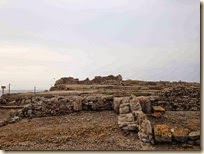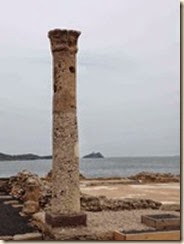Sardinia, another new port for us! Today is actually the day that we have to take a shuttle from the ship to the “terminal” – because there is no walking allowed inside the port. We want to be out there first thing to get the first shuttle at 8:00 – and we are actually the first ones in line waiting for the ship to be cleared and the gangway opened. Odd there’s not more people here, but we don’t care – we’re on the first shuttle!
It’s only a 3 minute ride, so we are out of the port and on our way in no time. Unfortunately the Hertz office doesn’t open until 8:30, so we have to cool our heels in front of the office for almost half an hour. Oh well – gives us time to study the little map we have and watch the foot traffic from the bus and train terminal. It’s crazy – it is Saturday morning and there are hundreds of teens streaming out of the bus station and into the city – while we are standing there I think we only see a handful of adults. What is with that? Just a morning in the city? I don’t know – it’s just weird! Ed says he and Butch Privett used to go into downtown Pittsburgh all the time on the bus on Saturdays, so maybe that’s all it is….funny though.
Hertz finally opens and the rental agent is lovely, except for a little glitch with the Sapphire card, I think it’s too high tech for some places, they need to take an imprint of the card, but the numbers aren’t raised enough….a little struggle there, but in the end all is well. We tell him where we are going, and he gives us the basic directions out of town, and also suggests we drive along the coast in the south because he says it is beautiful.
So we head out southwest to find Nora, the ancient ruins (yes, it is the continuation of the ruins tour!) of what is considered to be the oldest town in Sardinia. The roads are interesting – we’d read that there aren’t any traditional “highways” in Sardinia, and this coastal road is proving the point. Every 500 meters or so there’s a round-a-bout, even though this is the main road down the coast. Makes for fun driving (well, for the Navigator, although Ed doesn’t really mind!) and scenic routes. And we spot the famous flamingoes 5 minutes out of town! There are thousands of flamingoes on the island, spending the summers and winters here. Never got a picture (driving too fast) but they are everywhere we look.
We pass through a couple of small towns, and some little resort looking villages in the woods, then Alice takes us off the main road (gee, what a surprise) and off through Pula, the little town outside of Nora. After some twists, turns and little teeny village roads, we finally see signs again for Nora and head in that direction. There is a beach, a parking area and a long drive up to the archeological site. The road to the site is marked with a “no access” sign – but we don’t trust those signs after our experience in Katakalon. So we drive up the road – but alas – the sign was correct. Pooh. A tricky 3 point turn (that ends up being more like 5 points – and we’re in a teeny, tiny Panda!) and we’re back out to the parking area and walking back up the road.
Once inside the park, we have a decision to make. It’s about 9:35 and the next tour isn’t until 10:15. You can’t go alone – you must be accompanied. Hmmm….do we go down the coast and come back? Do we wait? We decide to wait, and pay our 15E entrance fee then go to the café next door for cappuccino. Turns out to be the best decision because here come the ship tours. Oh well, pictures probably won’t be the best with the people, but…who knows what it will be like later.
We wait with our drinks, and finally it is 10:15 and the cute girl who sold us the tickets is our guide. We have 4 others from the ship (who came in a taxi) with us and we all get audio guides (included in the fee – nice). We commence our tour, which was totally unexpected and completely interesting.
The city was developed by the Phoenicians due to its location with a port on each of 3 sides of the promontory, and an elevated rise where they could defend themselves against attack. The Carthaginians and then later the Romans took over the city, so there are lots of different types of architectural ruins here. Our guide takes us through the residential and shop areas, past original mosaic floors, showing us where the old fountain and springs were located – and how the sewage drains were constructed.
She’s very informative, and very adept at getting us around the ship tours and into areas where there are no people for photos. Great guide!
Next we visit the Roman baths, where we get a wonderful overview of how the baths were heated, how the vents worked and where the water came from and went. The baths are enormous and make for a great photo opp with the mountains and the Mediterranean sea right as a backdrop.
Further on into the site, we visit the residential area for the rich, where the four columns from a rich residents’ house still remain, along with incredible mosaic floors and a housing footprint that is huge – and our guide says that there would have been a 2nd floor as well!
We continue to walk the site, with explanations of the temples, the royal road that led to the temple by the sea and myriads of other little details about the different occupations and the way things were built.
As we end our tour, we pass by the amphitheater, which is still in use today for summer concerts. It’s nothing like the huge theaters we saw in Greece, but its beauty is actually in its quaintness, I think.
It’s really a lovely tour and a great site to explore with the monuments and ruins rising above the sea and the old (but not as old as the ruins) tower on the end of the promontory that is a lighthouse today, but previously was used as one of the series of communications towers that circle the island).
A delightful and unexpected surprise, this tour! And boy did we make the right decision to wait! There were 2 buses here when we entered, now as we are leaving at least 3 more are flooding the site. Good call to go on the first tour, allowing us to now blow this popsicle stand and get away from the ship tours…and into the southern coastal wilderness.





















No comments:
Post a Comment